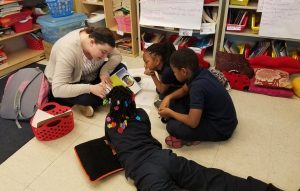On November 30, Professor Krystal Lewis-Pratl from the Special Education Department at Illinois State University, along with 22 preservice teacher candidates, visited the third grade classrooms of Stacie Ochiltree and Brenda Armstrong at Oglesby Elementary in Chicago’s Auburn-Gresham neighborhood as part of candidates’ course requirement. The school serves approximately 500 students. Both Armstrong’s and Ochiltree’s classrooms have a student roster of approximately 31 students each.
The mission of the Illinois State University Chicago Teacher Education Pipeline (CTEP) is to cultivate effective teachers for urban schools and their communities. One of the programmatic components that supports CTEP’s mission are the Course Design Grant (CDG) clinical visits that take place within the five partner neighborhoods.
Preservice teacher candidates complete part of the observation requirements for their teacher education course through the clinical visits. In Auburn-Gresham, CTEP works collaboratively with the Greater Auburn Gresham Development Corporation (GAGDC) on educational initiatives and projects with its partner schools.
Oglesby Elementary is an Auburn Gresham Gold school located in service area of GAGDC, a community-based organization that works with a largely African-American community on the South side of Chicago that encompasses all or parts of Ashburn, Auburn Gresham, Englewood, Greater Grand Crossing, Washington Heights, West Englewood, and West Chatham. As its website states, GAGDC works to foster and promote revitalization of the low-to-moderate income communities that they serve using comprehensive community development strategies, notably through their educational initiatives with their AG Gold schools.
Lewis-Pratl noticed a trend in her post-CDG trip evaluations that students, wished they knew more about the learners that they were engaging with, and wanted to find a way to address the issue. While taking an online webinar course, she learned about the online platform called FlipGrid. It is an online video discussion platform where participants can contribute to the learning process using “short, fun, and authentic” clips of themselves.
Often, traditional clinical visits involve teacher candidates visiting a host school, sitting in a classroom, observing teacher and students for a few hours, and then reflecting on what they observed. These interactions usually involve little-to-no prep work on the part of the K–12 students being observed or the University students coming into the classroom to do the observation. While there are benefits to this approach, CTEP and GAGDC work in partnership towards creating a more authentic student-to-teacher candidate interaction with every CDG visit that takes place. Lewis-Pratl presented FlipGrid as a possible tool to connect both the students at Oglesby and Illinois State prior to the visit and alleviate some of the anxiety each group feels with just “dropping in” for clinical visits.
At Oglesby, Ochiltree and Armstrong had been working on a unit of “Poems.” Given this knowledge, Lewis-Pratl and teacher candidates prepared minilessons stemming from this topic that they would teach in small groups upon their visit. The teacher candidates were equipped with literature that they felt would enhance their specific lesson and the unit as a whole, making sure to include works that spoke about culturally relevant poets such as Maya Angelou and Langston Hughes, among others.
Prior to the visit, the teacher candidates used FlipGrid to record a short video introducing themselves. “The school theme at Oglesby was ‘All Roads Lead to College,’ so we expanded on that, and had each of the ISU students discuss why they chose ISU and what led them into education,” said Lewis-Pratl.
In turn, Ochiltree and Armstrong used the videos to get the students excited about the visitors. Both teachers scheduled times throughout their day to highlight a different visiting teacher candidate, meanwhile letting the students know who their specific “teacher” would be on the day of the visit.
Each Illinois State teacher candidate was paired with three to four students as a small group to work with. “I wanted them to have some knowledge of the learners they would be visiting and not have it feel so much like a substitute teacher was coming in,” Lewis-Pratl said.
“When the ISU students made their introductions to their small groups I was able to have about nine of my groups make a response video to the ISU students,” Armstrong said.
In both classrooms, the small groups created response videos to the teacher candidates. This interaction allowed both the teacher candidates and the students to have a “more comfortable visit from the onset,” said Lewis-Pratl.
“Many students called out ISU students by name as they entered the classroom,” said Derris Cameron, the GAGDC liaison for CTEP and Illinois State. “I couldn’t help but think that the opportunity to communicate with ISU students prior to their arrival to Oglesby made for a warm welcome and set up prime conditions for the small group activity.”
Students actively participated within their small groups. Teacher candidates seemed comfortable interacting with the fairly “new” set of students sitting in front of them. “Some of the benefits were being able to hear the learners introduce themselves and say their names—they wanted to be able to accurately pronounce their name upon meeting them,” said Lewis-Pratl.
“I am extremely satisfied,” said Cameron. “I think FlipGrid overcame a real problem and barrier to how we do our work—clinical visits where the first time ISU and AG Gold School students meet (in person) is on the day of the visit. The next step is to fine tune the introduction process and to make the build-up to the visit an opportunity to contextualize what it is like to serve in AG Gold Schools.”
“I truly believe this was a more productive way to connect with the students of ISU and our students,” Armstrong said.


